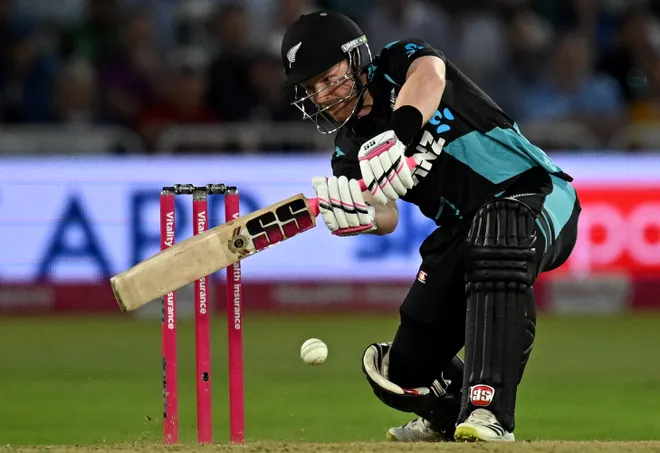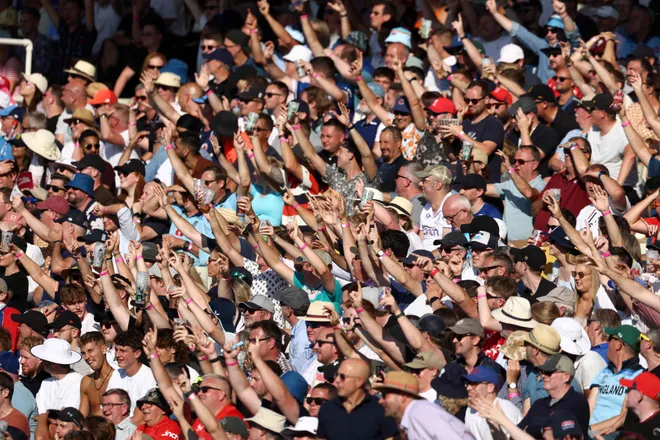Cricket in the Olympics? 2028 Games will feature sport for the first time in a century
When the International Olympic Committee signed off on five new sports for the 2028 Summer Games at a meeting in Mumbai on Monday, much of the attention in the U.S. revolved around the inclusion of flag football, or lacrosse, or the return of baseball and softball.
For the rest of the world, however, the headliner was a different sport: Cricket.
More than a century after its only prior Olympic appearance, at the 1900 Summer Games in Paris, the sport is officially back on the program for the Los Angeles Games, with six men's teams and six women's teams set to compete in 2028. For diehard fans in cricket-crazed countries such as India and Pakistan, it's an exciting move that feels long overdue. And for newbies, it may be a reason to finally dip a toe into the intimidating world of wickets and bowling.
A bat-and-ball sport that dates back to the 18th century, cricket doesn't have the American popularity of some of the other new Olympic sports coming in 2028, like lacrosse or baseball. But it still has plenty of domestic fans and recreational athletes − and data suggests that the cricket scene in the U.S. will only continue to grow.

In the wake of Monday's news, here's everything you need to know about why the sport was added to the Olympic program and what it means for cricket in the U.S.
Why did cricket become an Olympic sport?
Thomas Bach, the president of the International Olympic Committee, called it a "win-win situation."
With an estimated fanbase of around 2.5 billion people, cricket is considered to be the second-most popular sport in the world behind only soccer. The vast majority of those fans, however, are concentrated in a handful of cricket-loving countries − most notably on the Indian subcontinent.
The Olympics will give cricket a chance to expand its reach, while also giving the IOC a chance to tap into a dedicated fanbase that might not have otherwise tuned in to the Games.
"We have seen the growing international importance of cricket," Bach said in a news conference. "The Olympic Games want to represent and want to incorporate the most popular sports worldwide."
Why now?
It's unlikely that cricket would've returned to the Games without the introduction of a new format called Twenty20 − a condensed, jam-packed version of sport, in which matches generally span three or four hours rather than a full day or more.
The format debuted in 2003 and gained popularity in 2007 with the creation of the Indian Premier League, which has since blossomed into one of the most lucrative sports leagues in the world; A group of broadcasters paid $6.2 billion for a five-year TV rights deal in 2022, and each of the league's 10 teams are valued at $1 billion or more.
More international leagues have followed the IPL's lead. A professional T20 league in the U.S. called Major League Cricket just wrapped up its inaugual season earlier this year.
"For any sport coming into the U.S., a sport that’s played over a day or over five days is probably not viable in this day and age. But the T20 format has really sort of captured eyeballs around the world," Major League Cricket co-founder Vijay Srinivasan told USA TODAY Sports in a phone interview.
"Think of baseball, but all the action that happens in terms of home runs and outs and so on − a game of T20 cricket has all of that but in multiples of what you would see in a baseball game. So it’s a very action-packed format."
Beyond the emergence of T20, however, there's also a clear financial angle for Olympic organizers that likely contributed to the timing of cricket joining the Games.
India has long been the capital of the cricket world, and the country's TV rights for the 2028 Olympics have yet to be sold. The addition of cricket is expected to increase the value of those rights by at least $100 million.
"Traditionally, the Olympics have not derived massive value from that part of the world in terms of media values," said Srinivasan, who also founded Willow TV, which broadcasts cricket in the U.S. "So adding a sport that’s far and away the most popular one in that region ... (it) makes perfect sense."
How popular is cricket in the U.S.?
According to USA Cricket, the national governing body for the sport, participation numbers in the U.S. are relatively modest − roughly 200,000 cricket players competing in more than 400 local leagues. But an estimated 10 to 20 million other Americans watch and follow the sport.
Eraj Abidi, the president of 22 Yards Cricket Club based in the Washington D.C. area, said the sport is growing in popularity in the U.S. in part due to immigration trends.
"There’s a lot of cricket out there, because a lot of immigrants came from (the Indian) subcontinent, as well as from England and Australia," Abidi said. "(They) participated in the sport and have so much passion about it."
Abidi counted the D.C. area as one of the country's cricket hotbeds, in addition to parts of Florida, Texas, North Carolina, Illinois and California.
Srinivasan said one of factors that's impacted the growth of cricket in the U.S. is the number of top-tier cricket-specific venues, of which there are few.
Major League Cricket, which consists of six teams, hosted its games at two such venues − one in Grand Prairie, Texas and the other in Morrisville, North Carolina. The former is also slated to serve as a site for the T20 World Cup when it comes to the U.S. next summer, alongside venues in Lauderhill, Florida and New York.
Is the U.S. national team competitive in cricket?
According to the most recent world rankings released by the International Cricket Council, the federation overseeing the sport, the American men are currently ranked No. 22 in the world in T20, while the U.S. women are No. 23.
Neither team qualified for their most recent world cups, which were contested in a one-day international format that differs from T20. (The men's world cup is ongoing.)

The hope, of course, is that the prospect of competing at the Olympics could provide a boost. Venu Pisike, the chair of the USA Cricket board, called the sport's Olympic inclusion "a game-changer."
"This marks an exciting chapter in our journey to inspire and unite the cricketing community in the USA," he said in a statement. "We have a lot of work to do as the National Governing Body and a community to ensure we position ourselves to march thru this incredible journey (from the T20 World Cup next summer) to LA28."
Traditionally, the host country at each Olympics is given the chance to enter a team in each team sport, though it is unclear whether the U.S. will be automatically awarded a spot, due to the small size of the field. The Olympic qualification process for cricket will not be unveiled until 2025.
How will Olympic inclusion impact cricket?
Cricket's leaders spent several years pushing for the sport to be added to the Olympic program. Greg Barclay, the chairman of the ICC, called it "a priority" for the organization.
"The fact that the IOC confirmation of our selection occurred here in Mumbai, during the ICC Men's Cricket World Cup, is truly icing on the cake," Barclay said. "The innings has just begun, and we can't wait to see where this incredible journey leads."
Some in the cricket community are especially excited about the inclusion of a women's team event, and what it could do to help grow women's cricket (India's Women's Premier League launched in March). Others are curious to see what sort of impact the Games might have on the broader trajectory of a sport that has been around for hundreds of years and is already among the most popular in the world.
"I think the Olympics are sort of a bit of a shot in the arm," Srinivasan said. "It has the opportunity to, both in the U.S. and globally, allow cricket to expand its footprint beyond the few countries that really do love the game. Just doing that, I think there’s immense opportunities − both on the men’s and the women’s side of the game."
Contributing: The Associated Press
Contact Tom Schad at tschad@usatoday.com or on social media @Tom_Schad.
Disclaimer: The copyright of this article belongs to the original author. Reposting this article is solely for the purpose of information dissemination and does not constitute any investment advice. If there is any infringement, please contact us immediately. We will make corrections or deletions as necessary. Thank you.







